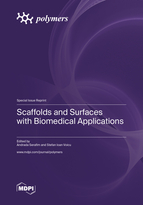Scaffolds and Surfaces with Biomedical Applications
A special issue of Polymers (ISSN 2073-4360). This special issue belongs to the section "Polymer Applications".
Deadline for manuscript submissions: closed (15 April 2023) | Viewed by 41126
Special Issue Editors
Interests: hydrogels with medical applications; nanostructured scaffolds; biofunctionalization; QCM-D; microstructural and architectural analyses; mechanical properties; rheological behavior
Special Issues, Collections and Topics in MDPI journals
2. Department of Analytical Chemistry and Environmental Engineering, Faculty of Chemistry and Materials Science, University Politehnica of Bucharest, 011061 Bucharest, Romania
Interests: synthesis and characterisation of polymeric membranes; biomedical applications of polymeric membranes; functionalization and derivatization of carbon-based nanospecies
Special Issues, Collections and Topics in MDPI journals
Special Issue Information
Dear Colleagues,
The synthesis and characterization of scaffolds and surfaces with improved properties for biomedical applications represents an ever-expanding field of research that is continuously gaining momentum. As technology and society evolves, the golden standard of autografts has been contested due to their lack of availability, and tremendous efforts have been dedicated to develop nature-inspired materials able to either undertake the functions of damaged tissue or contribute significantly to its repair. To this end, multidisciplinary research aiming at the engineering of new or improved materials has been conducted with the purpose of finding suitable candidates that replicate the characteristics of natural tissue with regard to its function, mechanical behaviour, microarchitectural features, etc.
This objective of this Special Issue is to present manuscripts that describe the synthesis of new materials with biomedical applications and their thorough characterization using conventional and emerging techniques. Emphasis will be placed on materials with improved bioactivity, tailored microarchitecture, enhanced mechanical properties, or personalized features to answer specific demands in the field of regenerative medicine.
Researchers are encouraged to submit relevant papers either in the form of full research articles, communications, or reviews. Submissions may cover, but are not limited to, the following topics:
- Surface functionalization for improved bioactivity and biomimicry
- Synthesis of scaffolds based on natural and synthetic polymers
- Synthesis of functionalized or composite polymer-based coatings
- Synthesis of polymeric membranes with biomedical applications
- Advanced characterization techniques for polymer-based materials with potential biomedical applications
- Materials for regenerative medicine.
Dr. Andrada Serafim
Prof. Dr. Stefan Ioan Voicu
Guest Editors
Manuscript Submission Information
Manuscripts should be submitted online at www.mdpi.com by registering and logging in to this website. Once you are registered, click here to go to the submission form. Manuscripts can be submitted until the deadline. All submissions that pass pre-check are peer-reviewed. Accepted papers will be published continuously in the journal (as soon as accepted) and will be listed together on the special issue website. Research articles, review articles as well as short communications are invited. For planned papers, a title and short abstract (about 100 words) can be sent to the Editorial Office for announcement on this website.
Submitted manuscripts should not have been published previously, nor be under consideration for publication elsewhere (except conference proceedings papers). All manuscripts are thoroughly refereed through a single-blind peer-review process. A guide for authors and other relevant information for submission of manuscripts is available on the Instructions for Authors page. Polymers is an international peer-reviewed open access semimonthly journal published by MDPI.
Please visit the Instructions for Authors page before submitting a manuscript. The Article Processing Charge (APC) for publication in this open access journal is 2700 CHF (Swiss Francs). Submitted papers should be well formatted and use good English. Authors may use MDPI's English editing service prior to publication or during author revisions.
Keywords
- bioactivity and biomimicry
- natural and synthetic polymer-based scaffolds
- coatings
- membranes
- functionalized surfaces
- modern characterization techniques
- biomedical applications
- regenerative medicine








